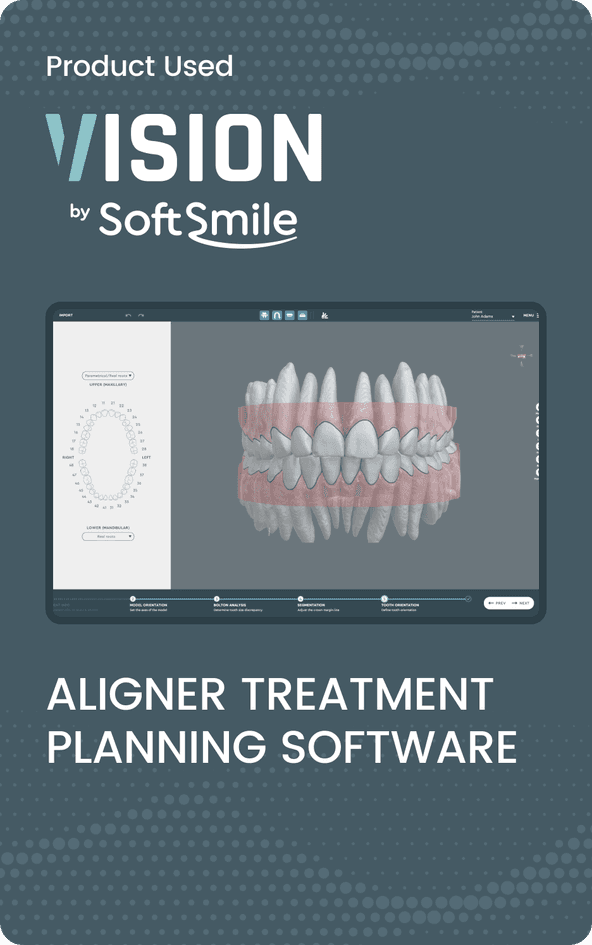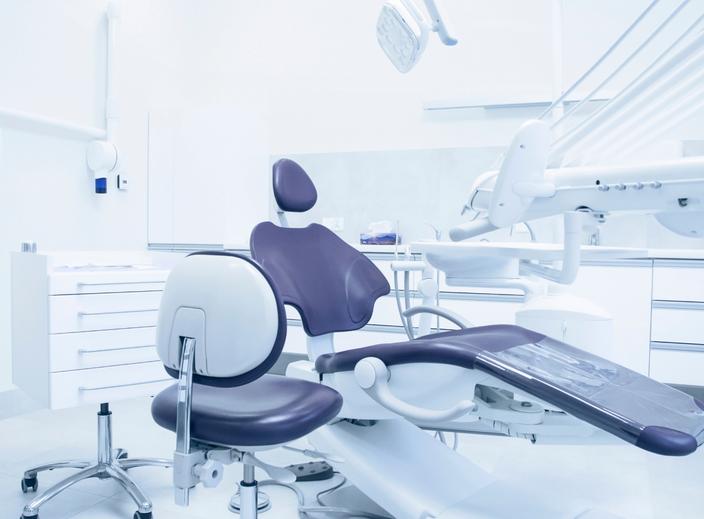|
Software Name |
Built-in Clinical Tools |
Multi-location Support |
Mobile App Available |
Patient Self-Service Portal |
Pricing Transparency |
|
SoftSmile Portal |
✓ |
✓ |
✓ |
✓ |
✓ |
|
CareStack |
✕ |
✓ |
✓ |
✓ |
✕ |
|
Curve Dental |
✕ |
✓ |
✓ |
✓ |
✕ |
|
Denticon |
✕ |
✓ |
✓ |
✓ |
✕ |
|
Dentrix Enterprise |
✕ |
✓ |
✕ |
✕ |
✕ |
|
Open Dental |
✕ |
✓ |
✕ |
✕ |
✓ |
|
DentiMax |
✕ |
✓ |
✕ |
✕ |
✓ |
|
Eaglesoft |
✕ |
✕ |
✕ |
✕ |
✕ |
|
tab32 |
✕ |
✓ |
✓ |
✓ |
✕ |
|
Practice-Web |
✕ |
✕ |
✕ |
✕ |
✓ |
|
Cloud 9 |
✕ |
✓ |
✓ |
✓ |
✕ |
|
iDentalSoft |
✕ |
✓ |
✓ |
✓ |
✕ |
|
ABELDent |
✕ |
✓ |
✕ |
✕ |
✕ |
|
Ortho Trac |
✕ |
✕ |
✕ |
✕ |
✕ |
|
Ortho2 |
✕ |
✓ |
✕ |
✕ |
✕ |
|
PerioVision |
✕ |
✕ |
unsure |
✕ |
✕ |
August 22, 2025
16 Best Orthodontic Practice Management Software for 2025
Comprehensive orthodontic practice management software is essential for any ortho practice to run smoothly. In this article, we’ll break down our 16 top picks.

Dr Sugz Maha
General Dentist
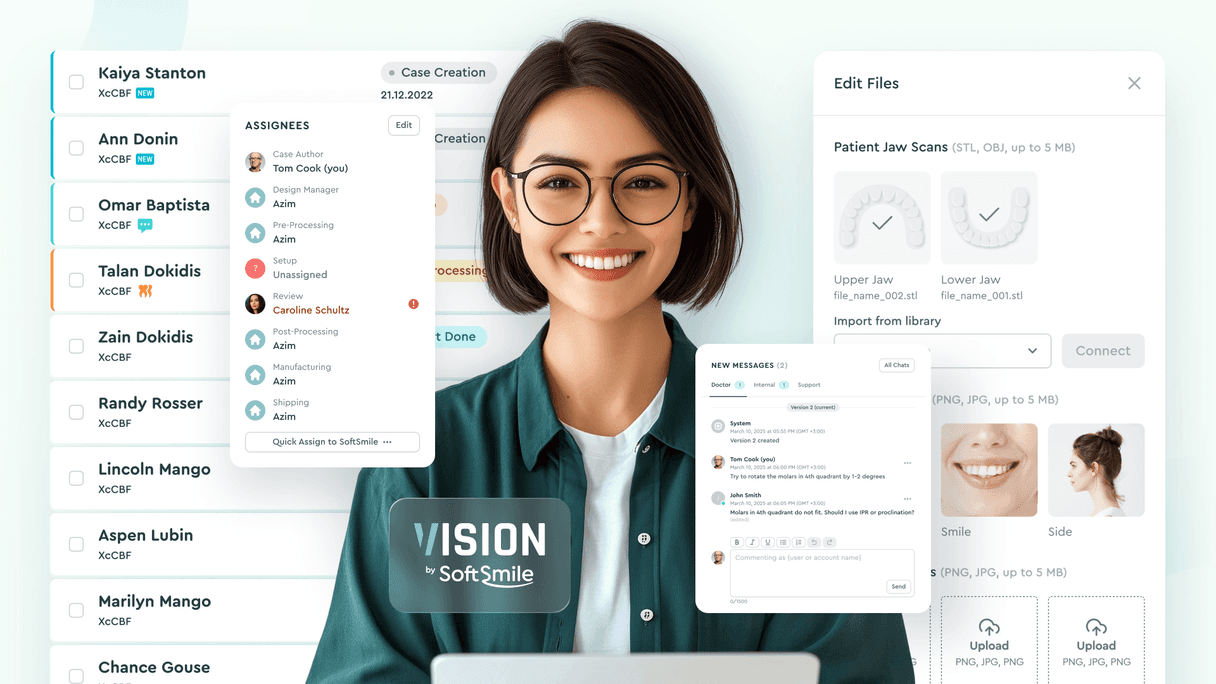
One can hardly run any clinic without the right software in 2025.
That’s why a good orthodontic practice management system is essential. The ROI on a solid system is enormous.
But with the array of software options available, it can be daunting to decide what’s best for your specific clinical setup.
In this guide, I’ll walk you through the best platforms available in 2025.
I’ve distilled all the information into something easily digestible for clinicians.
This provides a straightforward overview of each software’s strengths and limitations, so you can choose the right solution for your clinic.
By the end of this article, you’ll learn:
-
How much power your orthodontic practice management software could have — and what criteria to look out for
-
My top 3 picks for 2025 and why I recommend them
-
How to choose a system that supports your workflow (this is highly variable, so a must-read for practice owners)
-
What to expect from each of the 16 leading platforms available right now
Whether you’re opening your first clinic or upgrading from a system that’s holding you back, this orthodontic software comparison will support you in making a confident, informed decision.
What is Orthodontic Practice Management Software?
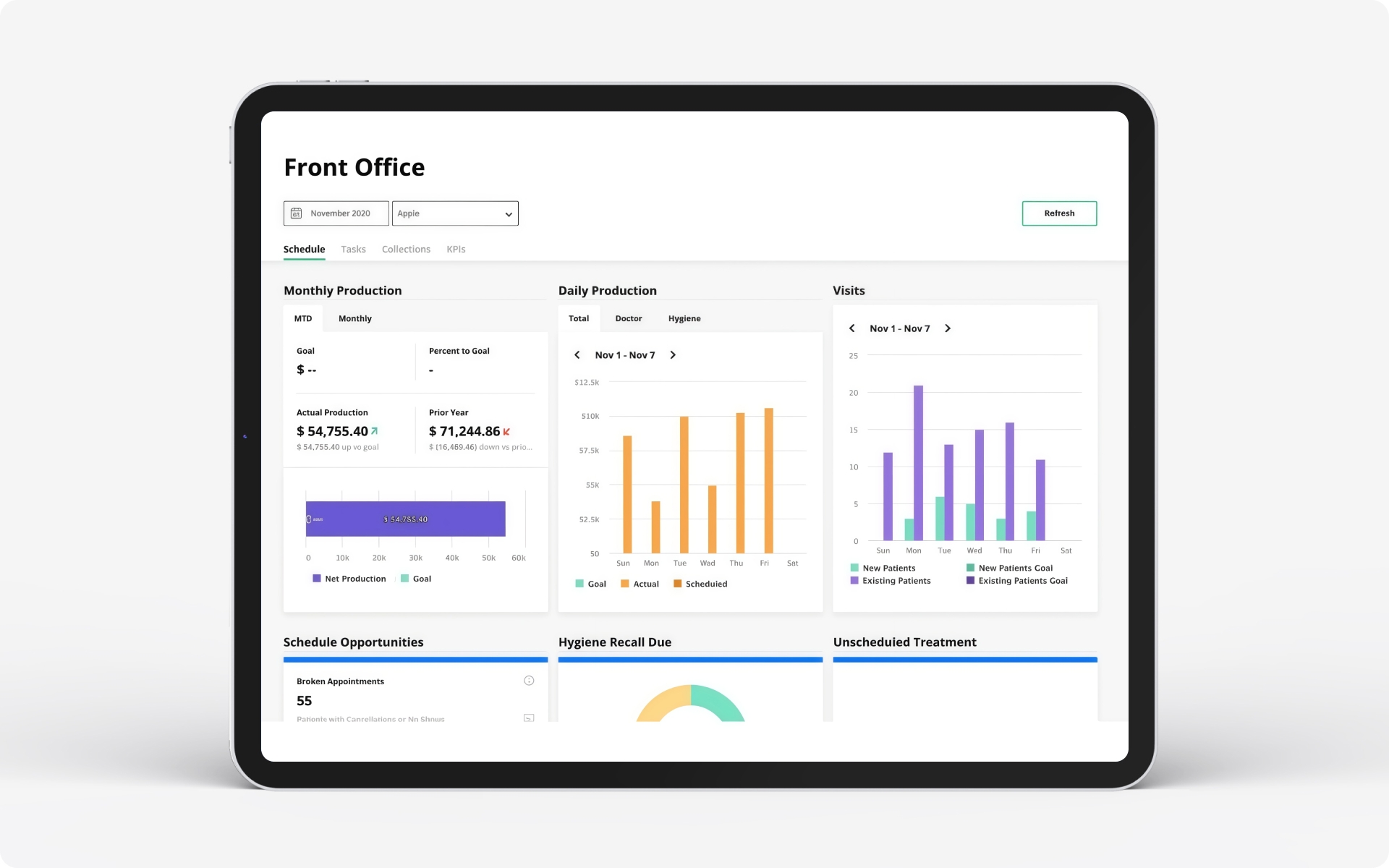
Orthodontic practice management software is the engine of a modern clinic in 2025.
The right choice means you and your team will spend more time focusing on patients.
A good system will help you manage everything from appointments to payments to communication — all in one central hub.
At the bare minimum, a good management software should support:
-
Scheduling appointments
-
Patient communication (via SMS, email or patient portals)
-
Billing and insurance claims
-
Processing payments
-
Data sharing with other authorised providers
Editor’s Choice: My Top 3 Picks for 2025
My choices are based on which companies have a consistent track record for delivering on their promises.
If I had to shortlist the three platforms that consistently deliver across key clinical and operational needs — it would be these:
-
SoftSmile Portal stands out as the true all-in-one platform. It handles the two most critical pieces of the puzzle: clinic management and streamlining your clinical workflow. Its integration with aligner design and treatment planning puts it ahead for ortho focused workflows.
-
CareStack is a cloud-based option built for multi-location scalability. It’s ideal for group practices or clinics looking to grow.
-
Curve Dental offers an excellent UI and user experience. It’s commonly used by owners who are transitioning from older systems.
Each of these solutions offers a robust set of tools that work effectively for every size of practice.
They’re the most intuitive to use, and backed by reliable support teams—something I’ve found is often overlooked during the buying process, but becomes crucial if things go wrong during a clinical day.
We’ll cover each in detail later. For now, here are quick orthodontic practice management software reviews of the best all-rounders available today.
How can practice management software enhance your orthodontic business?
A good orthodontic management software is no longer a nice-to-have addition to a clinic.
Here are some of the biggest benefits that you can get from a good orthodontic practice management software:
Easier patient scheduling
Missed appointments can cost your practice dearly.
These tools make your reception team’s job easier through colour coding types of appointments, and finding the appropriate time slot for each treatment.
Increased efficiency
Hours can be freed up by allowing your management software to carry out simple tasks.
Plus, a good cloud solution means clinicians can access their notes and records from home.
Secure patient data storage
In-house servers can present a significant amount of cost and upkeep to maintain for a single-site practice.
This gives you the peace of mind that your valuable data is being handled safely and securely.
Easy billing and collections
The integrated billing tools in most orthodontic practice management software solutions can reduce manual input errors.
Similar to the point made previously, automated follow-ups can also improve collection rates while freeing up admin time for more complex tasks.
Smarter treatment planning and imaging
Beyond purely administrative benefits, you can now have platforms, like SoftSmile Portal, that include more clinical functionality.
This includes features such as aligner staging, cephalometric tracing, and digital treatment planning.
What to Consider Before Choosing the Right Practice Software
The right software should complement your workflow.
Here are some key factors that you should consider before you commit:
Infrastructure
Some solutions are entirely cloud-based, while others require local installation. You need to factor in your clinic’s existing IT environment to see what would be easiest to integrate.
Ease of use
You want to avoid overly complex orthodontic management software that could confuse your team.
Customization
You don’t want to overhaul your entire clinic’s workflow for the sake of integrating a new orthodontic practice management software. A good platform should offer flexibility in all aspects of its use case.
Integration
The ability to integrate with multiple external platforms is becoming increasingly important. With the plethora of imaging softwares and financial planning apps, you want to ensure that they work seamlessly with the software you choose.
Customer support and training
During the early days of onboarding, it is crucial to have a prompt support system.
Just imagine having a system update that renders most of the software unusable. This could cause mass interruptions in your schedule, which can result in unhappy patients.
Cost
Pricing models vary significantly. Some charge per user — which can prove to be costly in a multi-site clinic. Others may charge per location, and a few offer all-inclusive subscriptions.
1. SoftSmile Portal

Free Demo: Yes
Price: On request
Support: Responsive via live chat and email
Hosting: Cloud-based
HIPAA Compliant: Yes
SoftSmile Portal is one of the only practice management software on this comparison that caters entirely to an orthodontic workflow.
It covers the basics you'd expect: patient scheduling, billing, payment collection, communication, and cloud-based access.
But, its main differentiator is how well it manages to tie in both with the clinical and the administrative tasks.
In the case of SoftSmile, they integrate aligner staging, Cephalometric tracing, and 3D treatment planning within one solution.
If you’re running an aligner-heavy practice or you're interested in bringing planning and case submission under one roof, this software does the heavy lifting. The interface is sleek, and the workflows have been mapped out by someone who knows what it’s like to be chairside.
Key Features
-
Aligner design: offices can commission high-quality aligner designs from SoftSmile’s team of experienced clinicians, all completed in a timely fashion.
-
Custom setups: you can create customized treatment plans and tailor patient management tools to suit your needs.
-
Tailored workflows: you may assign roles, automate status updates, and save company-specific settings.
-
Secure data management: SoftSmile’s cloud-based software helps protect you from data leaks while ensuing FDA compliance.
-
Automated settings: you can streamline every aspect of your office and work at 100% efficiency with the help of SoftSmile’s AI-powered technologies.
Pros of SoftSmile Portal
-
Clinical tools and admin functions in one system
-
Excellent UI that doesn’t feel overwhelming
-
Tailored to ortho workflows rather than generic practice needs
Cons of SoftSmile Portal
-
Still relatively new, so may not integrate with legacy imaging systems
-
Pricing isn’t published, which can slow down decision-making for budget-focused clinics
2. CareStack
Free Demo: Yes
Price: On request
Support: Dedicated onboarding, email and phone support
Hosting: Cloud-based
HIPAA Compliant: Yes
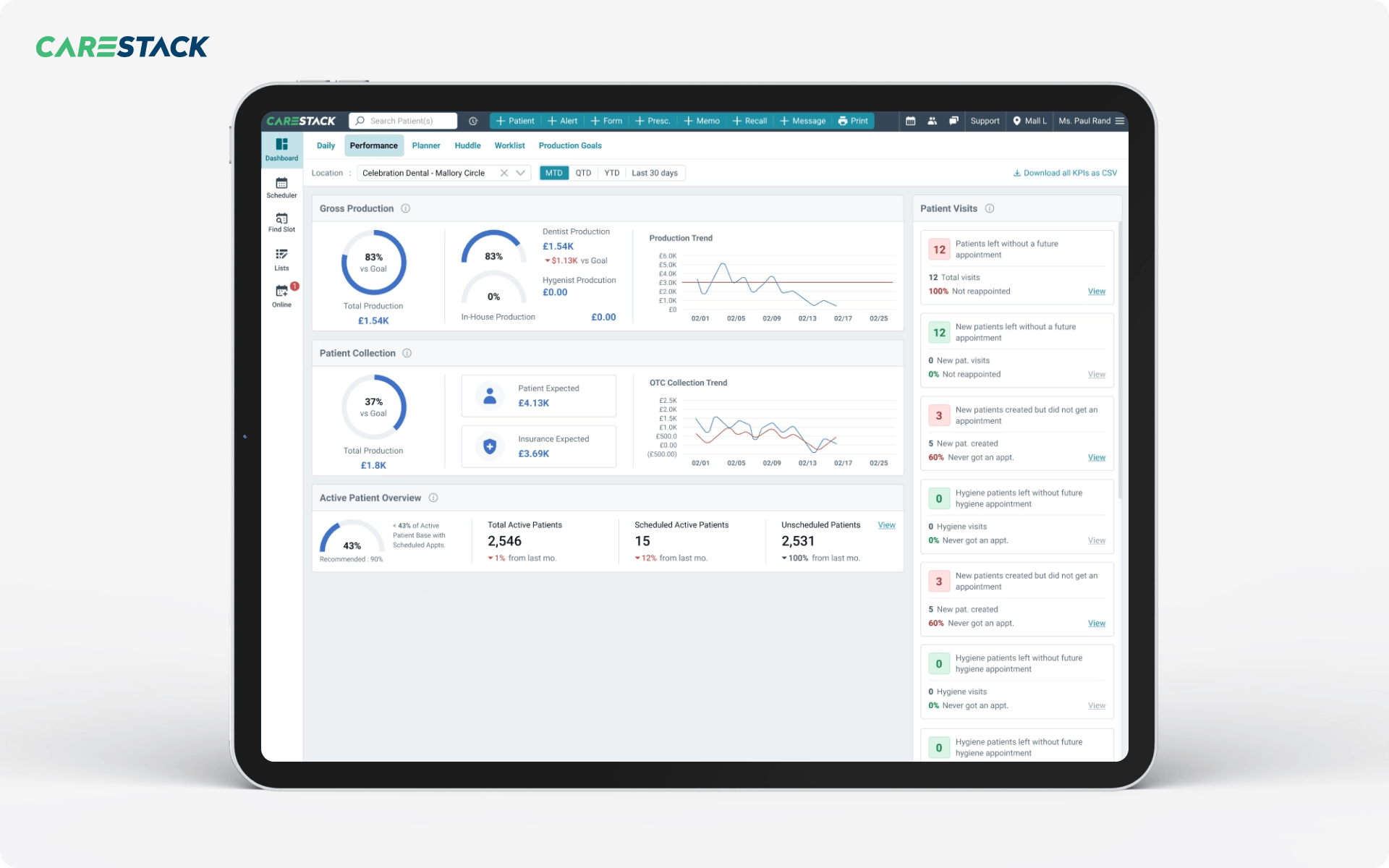
CareStack is a fully cloud-based solution designed to centralise the core functions of a dental or orthodontic clinic into one system.
Its main strength is being able to do all of this from a single login.
However, most users report that it becomes intuitive after the initial onboarding period. One of the more practical features is its real-time analytics dashboard, which gives useful oversight across both clinical and financial KPIs.
Key Features
CareStack houses many of its features within the software, which can make it a cost-effective solution for certain practices.
With its cloud access, you reduce the need for in-practice servers, which can free up resources within your clinic.
Pros of CareStack
-
Strong for multi-location setups
-
Centralised analytics
-
Secure cloud access
Cons of CareStack
-
Feature-rich platform may be excessive
-
Visual UI feels dated compared to some competitors
-
Pricing can vary depending on feature set and user volume
3. Curve Dental

Free Demo: Yes
Price: On request
Support: Email, phone, and online chat
Hosting: Cloud-based
HIPAA Compliant: Yes
Curve Dental is a cloud-based solution for general practices.
Their main focus is on usability. Curve is well designed for teams with little technical experience, making the onboarding process smoother.
That said, it can be easily integrated into an ortho practice. As a result, you won’t find clinical features like aligner staging or Ceph analysis baked into the platform.
Within this orthodontic software comparison, this may be something to consider.
Key Features
Curve Dental ticks the boxes for basic clinical management. It offers basic tools, which can make it functional for a single-site owner. It also supports integrations with several platforms, therefore its functionality can be enhanced when paired with other providers.
Pros of Curve Dental
-
Clean UI suitable for limited tech experience
-
Cloud-based with strong uptime
-
Integrates well with popular third-party tools
Cons of Curve Dental
-
Not built specifically for ortho workflows
-
No built-in clinical tools for treatment planning
-
May require bolt-ons for advanced functionality
4. Denticon
Free Demo: Yes
Price: On request
Support: Dedicated account manager, email, and phone
Hosting: Cloud-based
HIPAA Compliant: Yes

Denticon, by Planet DDS, is one of the more established cloud-based platforms in the space. It’s commonly used by both general and specialty practices.
Multi-site clinics can benefit from the cloud-based nature of the software, allowing teams to access real-time data remotely.
However, Denticon doesn’t have built-in clinical tools specifically tailored to orthodontics.
Therefore, if you need features such as aligner staging or Cephalometric tracing, these would still need to be managed through third-party systems.
Key Features
Denticon includes many of the fundamental tools for running a successful practice. You can carry out basic functions without hassle.
It is suitable for large, complex organisations with enough centralised oversight.
Pros of Denticon
-
Built for large practices and DSOs
-
Solid integrations
-
Well-established
Cons of Denticon
-
No native tools for orthodontic treatment planning
-
Interface can feel dated
-
Feature-heavy platform may require training to fully utilise
5. Dentrix Enterprise
Free Demo: Available
Price: On request
Support: Phone, online resources, live training available
Hosting: Cloud or on-premise options
HIPAA Compliant: Yes

Dentrix Enterprise is the type of software that was clearly built with larger-scale clinical operations in mind.
Within this orthodontic software comparison, it is the software most often used by multi-site clinics, community health centres, and DSOs.
For a simple clinic with a small team, this level of customisation can feel daunting. The learning curve can be steep.
Its strength is in its administrative depth.
Whilst the software is reliable, the clinical aspects would need to be managed separately.
Key Features
Dentrix Enterprise continues to be popular amongst multi-provider clinics. They accommodate varied workflows, which can be useful when you are managing multiple clinicians.
Pros of Dentrix Enterprise
-
Suited to high-volume operations
-
Strong user controls
-
Established track record
Cons of Dentrix Enterprise
-
Interface feels clunky
-
Not designed with orthodontics as a primary focus
-
Initial setup can be time-intensive
6. Open Dental
Free Demo: Yes
Price: Transparent, starts from ~$179/month
Support: Phone and email support included
Hosting: Local or cloud (via third party)
HIPAA Compliant: Yes

Open Dental has built a reputation on transparency.
It's one of the few platforms where you can actually view full pricing and feature lists without having to book a demo.
A potential drawback is that the software is locally hosted by default. This can have its benefits in remote locations with poor internet access, but many of the solutions are now cloud hosted, which makes remote access more straightforward.
For some, the trade off for budgetary purposes is worth it.
Key Features
Open Dental offers a wide range of features that can help to streamline your practice. It has basic functionality. You can tailor it to your practice if you're comfortable with a bit of technical setup.
Pros of Open Dental
-
Transparent pricing
-
Strong user community
-
Reliable scheduling and billing
Cons of Open Dental
-
No ortho specific clinical tools
-
UI looks dated compared to newer systems
-
Cloud hosting requires external configuration
7. DentiMax
Free Demo: Yes
Price: Transparent packages from ~$249/month
Support: Phone, email, and training options
Hosting: Cloud or local
HIPAA Compliant: Yes
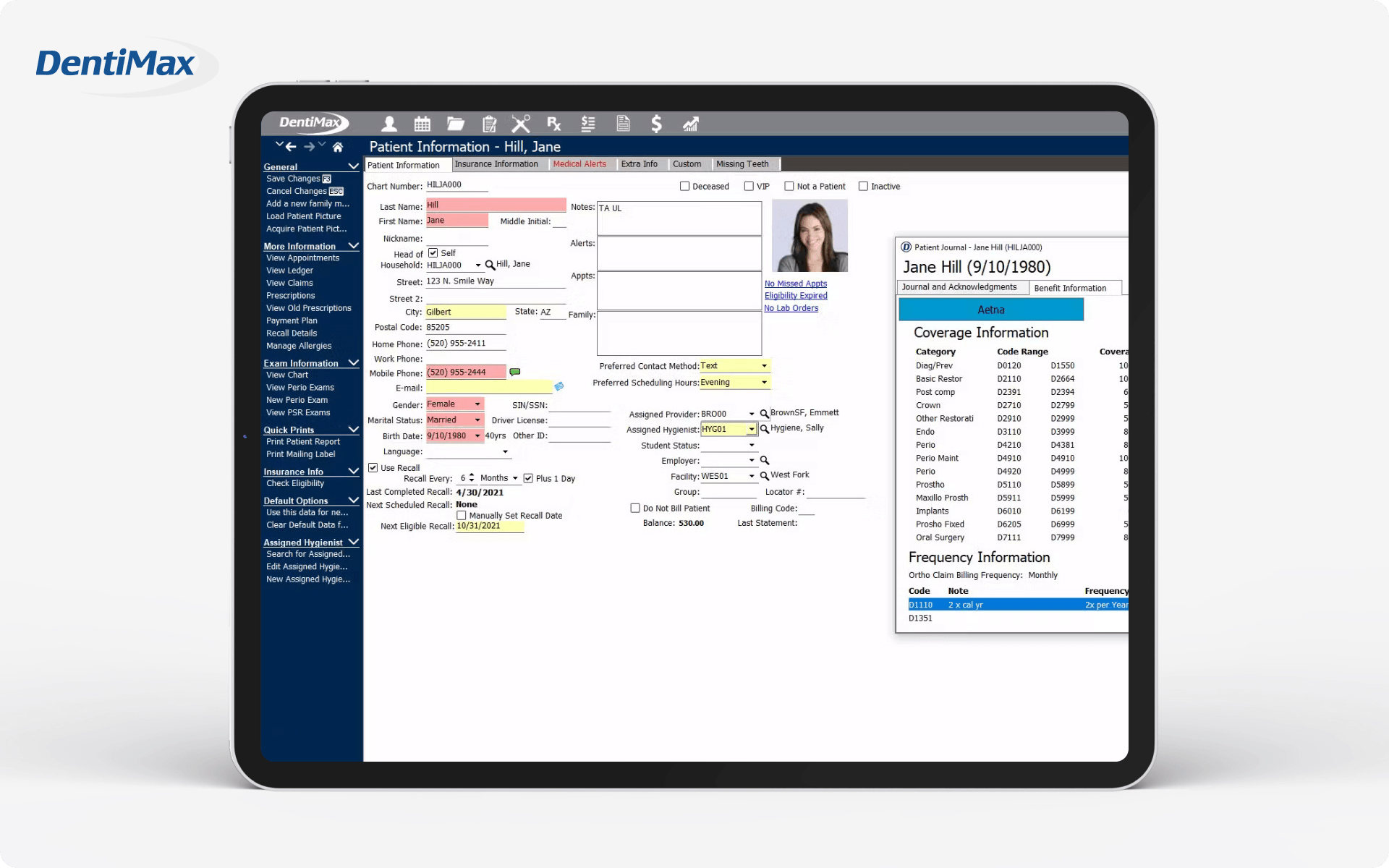
DentiMax is currently in that middle ground between legacy software and cloud-based platforms.
The major differentiator in its offering is its Dream Sensors.
They offer both cloud and in-office versions, and in terms of function, it covers the essentials.
If you are after a seamless integration between software and hardware for your intra-oral imaging, this could be something to consider.
From an ortho perspective, though, it's not the most tailored option.
That said, DentiMax can appeal to budget-conscious clinics.
Key Features
You can use customisable chart templates, and the x-ray integration is second to none. The Dream Sensors come highly recommended, but this tends to be more useful in general practice with a higher volume of intra-oral radiographs..
Pros of DentiMax
-
Dual hosting flexibility
-
Easy integration with DentiMax imaging hardware
-
Simple interface
Cons of DentiMax
-
Not built for orthodontic workflows
-
Clinical functionality is basic
- Lacks deeper automation or customisation features
8. Eaglesoft
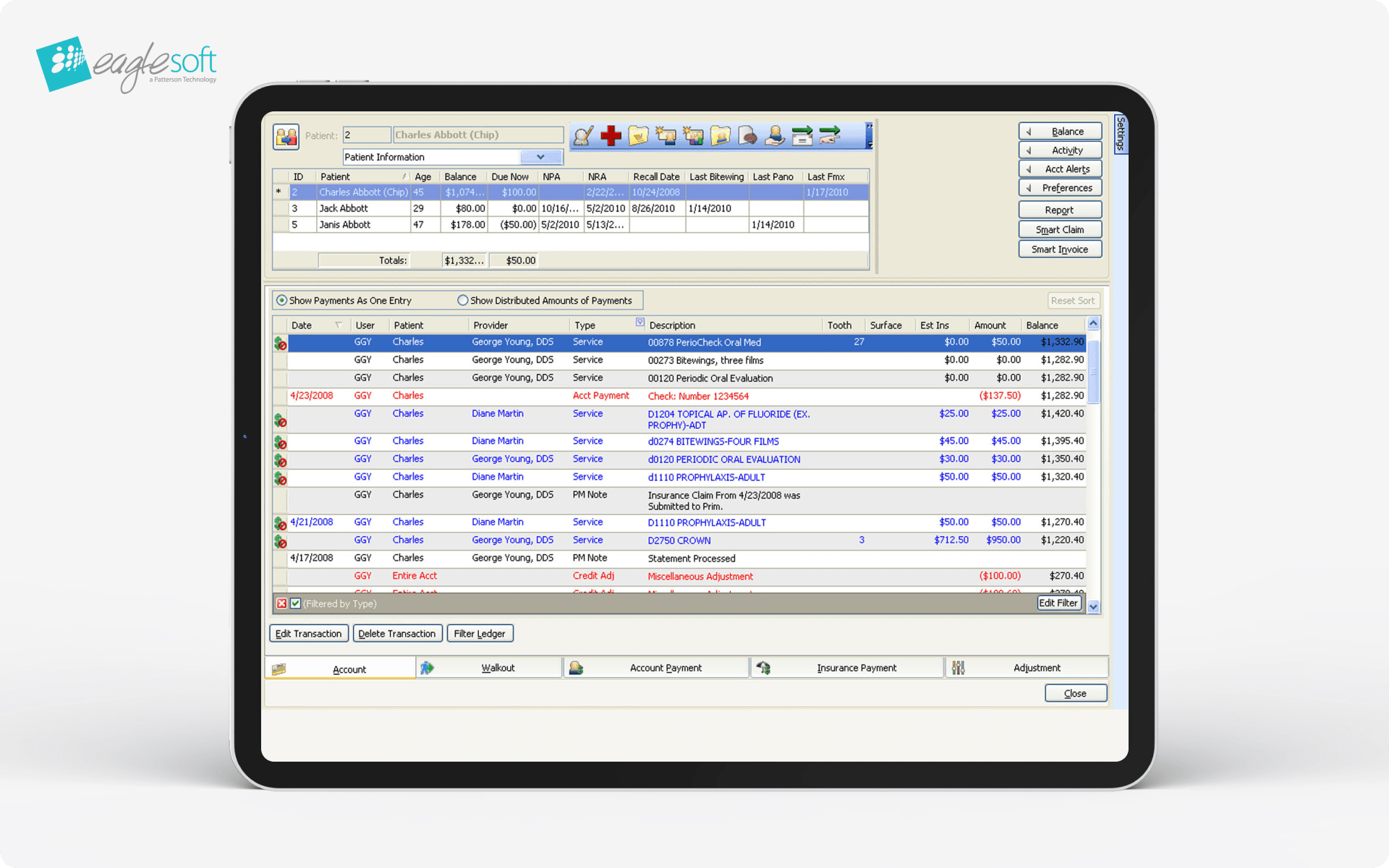
Free Demo: Yes
Price: On request
Support: Provided via Patterson Dental network
Hosting: Primarily local
HIPAA Compliant: Yes
Eaglesoft is developed by Patterson Dental, which means it's deeply tied into their ecosystem.
If you use other products by Patterson Dental, this could be a major draw for you.
But when you start looking through the lens of an ortho workflow, you’ll notice its limitations fairly quickly. There’s no built-in features that make it feel purpose-built for specialist care.
If you are already embedded in the Patterson ecosystem, this could be less of an issue.
Key Features
Eaglesoft offers standard admin features like scheduling, billing, e-claims, and clinical charting. It integrates with Patterson's imaging systems and has some in-built reporting tools.
Pros of Eaglesoft
-
Long-standing reputation
-
Integrates well with Patterson hardware
-
Stable system
Cons of Eaglesoft
-
Lacks specialist ortho features
-
Interface feels dated
-
Cloud access isn’t seamless or native
9. Tab32
Free Demo: Yes
Price: On request
Support: Email, phone, onboarding training
Hosting: Cloud-based only
HIPAA Compliant: Yes
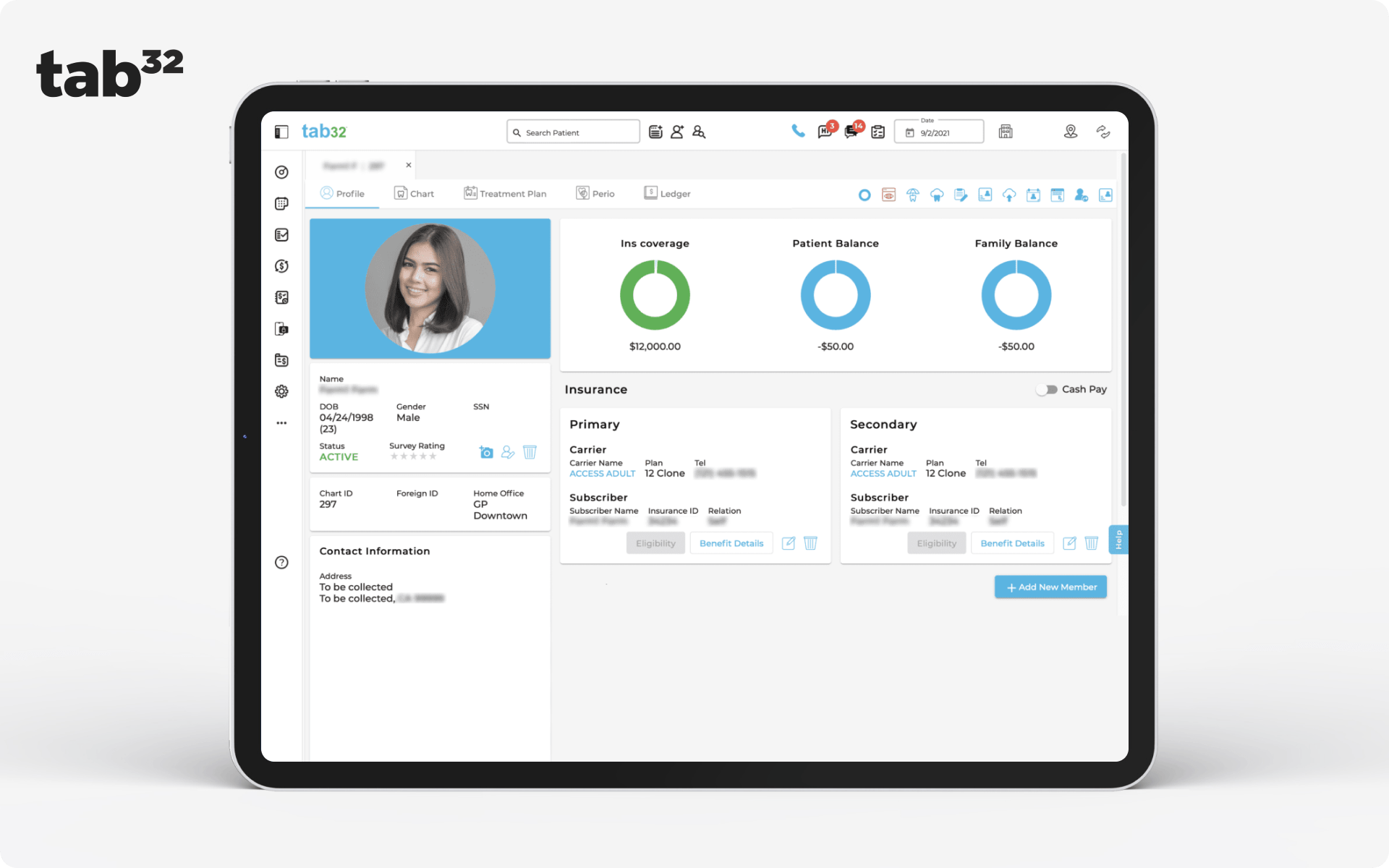
Tab32 positions itself as a truly cloud-native platform, which was designed to be accessed from anywhere.
They have done a great job in bringing multiple systems into one place.
However, as an ortho practice, you will need to find workarounds for treatment planning or Ceph analysis.
The interface seems simple to use. If you are used to working on legacy systems, the transition to tab32 will have an adjustment period.
Key Features
Tab3’s cloud offering can be convenient for multi-site owners. In particular, its patient-facing features are a standout.
Pros of tab32
-
Built in the cloud
-
Strong self-service functionality
-
Suitable for growing practices
Cons of tab32
-
Lacks ortho specific clinical tools
-
Integrations required
-
Pricing isn’t easily accessible
10. Practice-Web
Free Demo: Yes
Price: Transparent pricing available
Support: Phone and email
Hosting: Primarily local; remote access possible
HIPAA Compliant: Yes
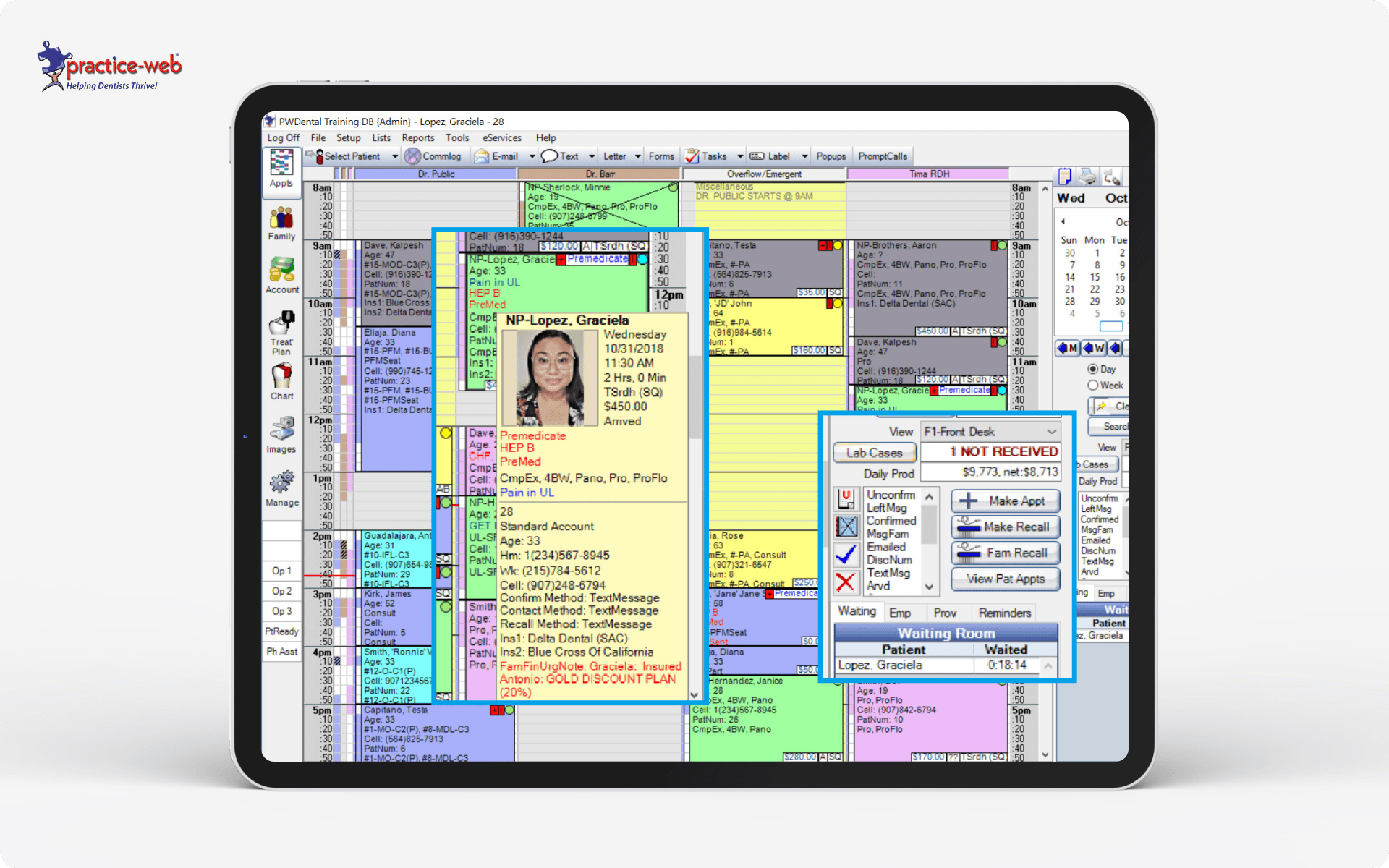
Practice-Web is one of the more affordable platforms on this list.
It’s built for small practices that require basic functionality.
That said, it is behind its competitors in terms of user experience.
From an orthodontic standpoint, the clinical tools are limited.
Whilst it has certain smart features like teledentistry, it is not catered for more complex use cases.
However, if cost is the main driver, it still remains a solid choice in this comparison.
Key Features
It has many of the fundamental features of practice management software such as email marketing, e-prescribing, and claims processing.
Pros of Practice-Web
-
Low-cost entry point
-
Stable core features
-
Transparent pricing
Cons of Practice-Web
-
Outdated UI
-
Not built with orthodontics in mind
-
Minimal built-in analytics or automation features
11. Cloud 9
Free Demo: Yes
Price: On request
Support: Email, live chat, and training options
Hosting: Cloud-based only
HIPAA Compliant: Yes

Unlike the last few software that I’ve covered so far, Cloud 9 is one of the few platforms on this list built specifically with ortho practices in mind.
It’s designed to be used by specialists, which means the workflows are more intuitive.
Whilst it doesn’t have a built-in aligner design module like SoftSmile, it does integrate well with imaging systems.
On the admin side, the system is solid, though not as visually refined as some newer players.
Key Features
Cloud 9 includes many fundamental tools. It’s built to serve multi-site practices and mobile specialists.
Pros of Cloud 9
-
Designed specifically for orthodontists
-
Reliable cloud access
-
Clean workflow
Cons of Cloud 9
-
No built-in aligner planning tools
-
Interface may feel dated
-
Reporting tools aren’t as customisable
12. iDentalSoft
Free Demo: Yes
Price: On request
Support: Phone, email, and live onboarding
Hosting: Cloud-based
HIPAA Compliant: Yes

iDentalSoft is positioned as an orthodontic management software.
They pride themselves on their level of tech support, which is invaluable.
This is an attractive proposition for smaller practices that want to save space by eliminating clunky servers.
However, despite the fact that it’s user friendly, iDentalSoft isn’t designed specifically for orthodontists.
Key Features
iDentalSoft’s core strength is its ease of use. It doesn’t overwhelm you with features. Everything syncs in real-time, and there’s minimal need for IT intervention.
Pros of iDentalSoft
-
Clean UI
-
Strong patient portal
-
Fast onboarding
Cons of iDentalSoft
-
Lacks ortho specific tools
-
Limited flexibility for larger practices
-
Higher-tier pricing withholds certain features
13. ABELDent
Free Demo: Yes
Price: On request
Support: Email, phone, and remote access support
Hosting: On-premise or cloud
HIPAA Compliant: Yes

ABELDent is a Canadian-developed software that’s been around for decades, and its longevity is testament to the depth of functionality.
The standout feature here is stability.
It handles the basics with competence. This is appealing for less tech-savvy clinicians.
You won’t get fancy dashboards or the AI features that many orthodontic practice software solutions do — but you will get software that runs smoothly.
That said, its capabilities are minimal. While it does offer some integration with imaging systems, it’s not built for specialist care. This makes it a better fit for general practices.
Key Features
ABELDent’s USP is its reliability. It’s not trying to be an all-in-one system. It’s trying to be the backbone of practices that value control, predictable workflows, and gradual tech adoption.
Pros of ABELDent
-
Proven track record
-
Choice between cloud and local installation
-
Stable performance
Cons of ABELDent
-
Not suited to ortho specific workflows
-
Interface feels outdated
-
Customisation options are limited
14. OrthoTrac
Free Demo: Yes
Price: On request
Support: Phone and Carestream support portal
Hosting: Local
HIPAA Compliant: Yes

OrthoTrac is a practice management system that has been developed specifically for orthodontic practices.
Its strength lies in familiarity.
There are also some specific features like bracket tracking and treatment card management, which many general systems lack.
However, the platform hasn’t evolved as much as competing software.
The desktop UX appears to be more dated compared to competitors.
As a result, there are limited integrations available for adjunctive software.
Key Features
OrthoTrac’s main differentiator is its treatment tracking, which includes a range of modules.
Pros of OrthoTrac
-
Built specifically for ortho workflows
-
Familiar for long-standing users
-
Stable
Cons of OrthoTrac
-
Not cloud-based
-
Interface feels outdated
-
Not ideal for modern practices
15. Ortho2
Free Demo: Yes
Price: On request
Support: Training, email, phone, and client portal
Hosting: Cloud-based
HIPAA Compliant: Yes
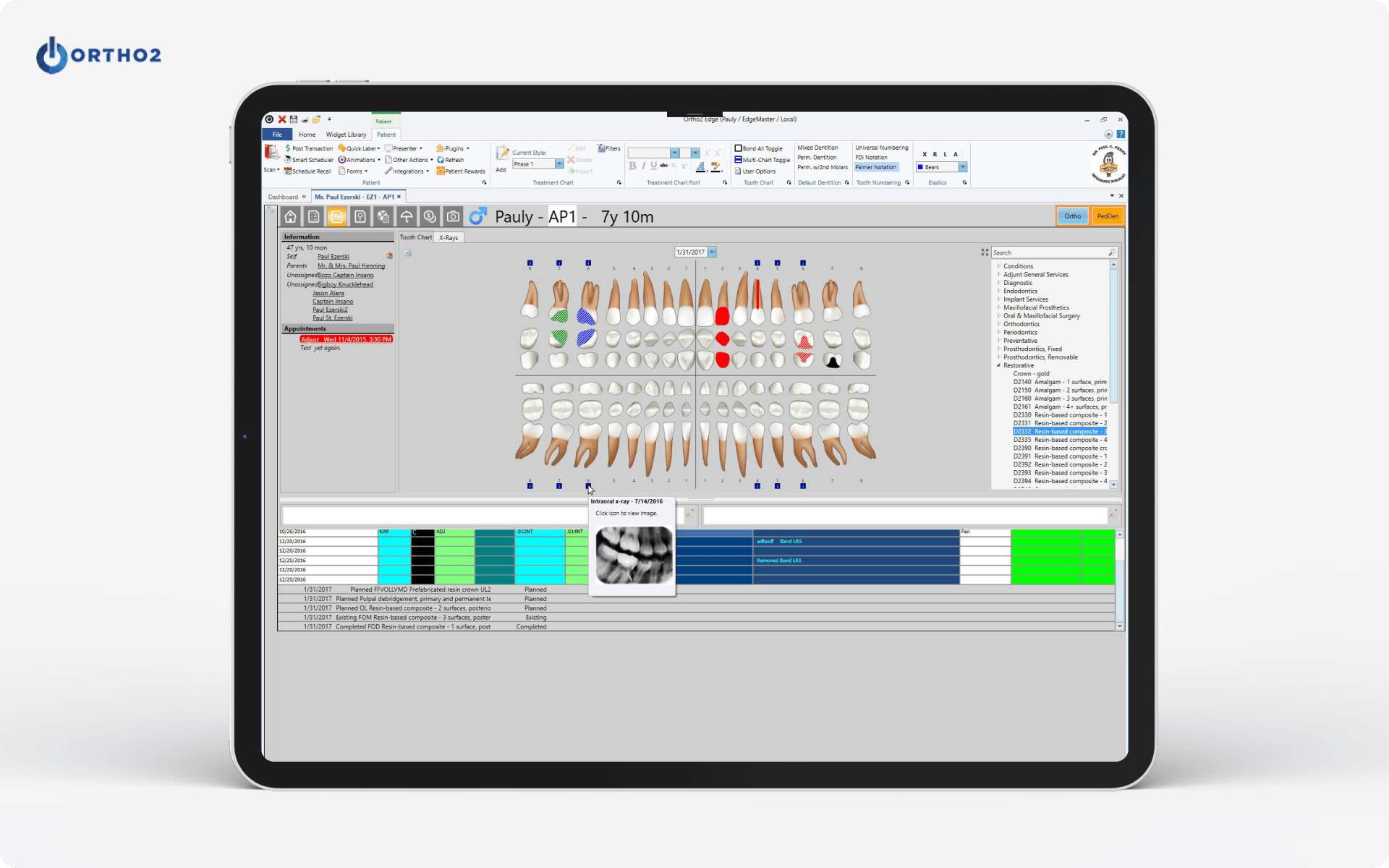
Ortho2 is one of the longer-standing names in the orthodontic software space.
Their latest platform, Edge Cloud, brings the product firmly into the modern era.
The visual treatment timeline is one of its more unique features. This allows clinicians to track their case progression across visits, which is particularly useful for clinics managing a high volume of aligner or fixed appliance cases.
Some users suggest that onboarding can feel a bit heavy, which can be tough for newer users to navigate.
Key Features
Ortho2 stands out with its treatment tracking features. Its Edge Cloud platform was built to support larger ortho teams needing centralised tools.
Pros of Ortho2
-
Designed exclusively for orthodontists
-
Built-in treatment tracking
-
Secure cloud hosting
Cons of Ortho2
-
Interface is outdates
-
Setup is time-intensive
-
Less intuitive for smaller teams
16. PerioVision
Free Demo: Yes
Price: On request
Support: Email, phone, and Carestream Dental support
Hosting: Local
HIPAA Compliant: Yes
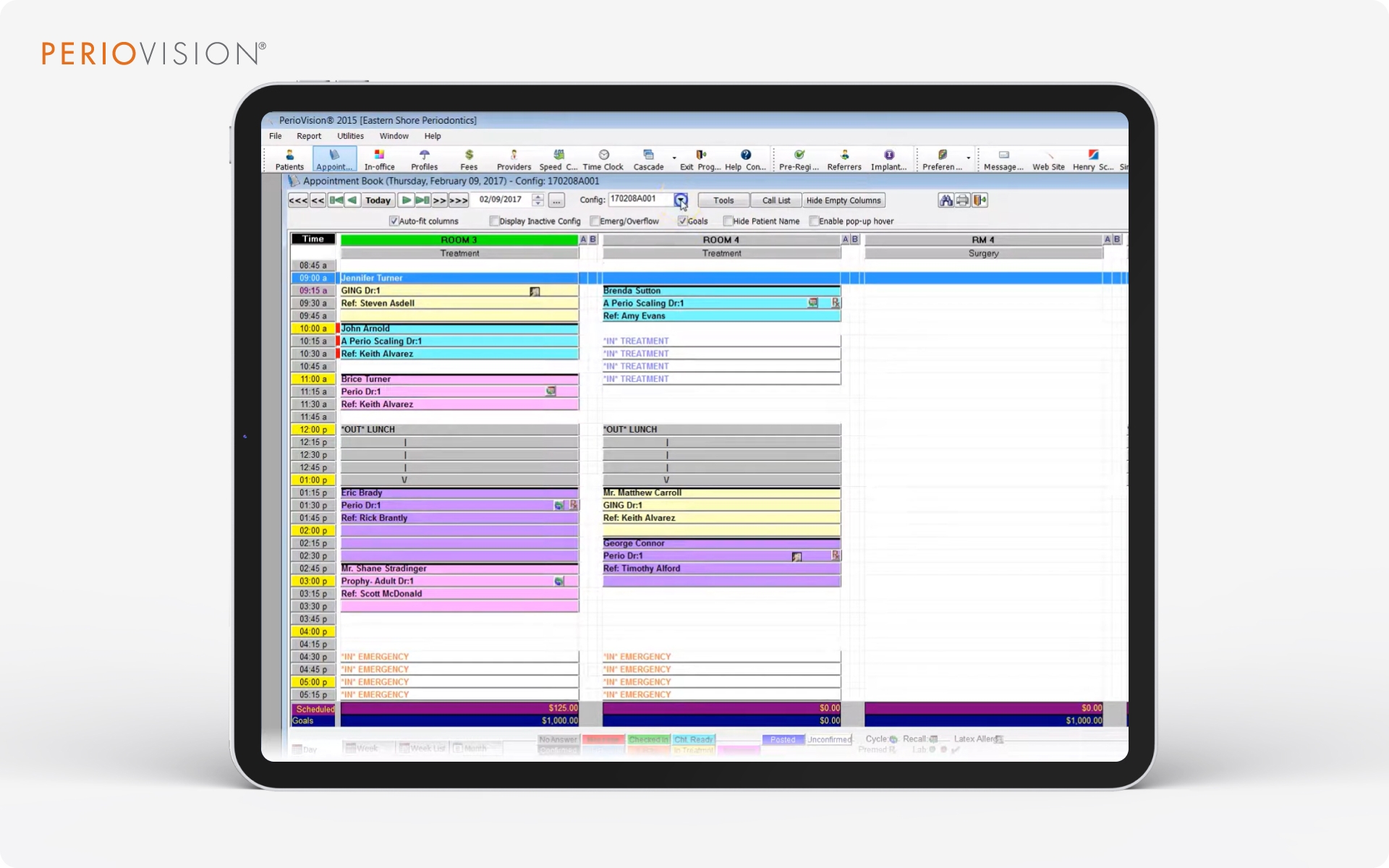
PerioVision was originally developed for periodontal practices, and that focus shapes how the software functions today. It’s a solid platform if you’re working in perio or general dentistry.
But, its major drawback is that it’s not built with orthodontic treatment planning in mind.
As there is limited information available about integrations, it would be difficult to provide any recommendations about compatibility.
Key Features
PerioVision offers a range of tools suited to perio. It is a less relevant choice for ortho clinics.
Pros of PerioVision
-
Strong periodontal charting tools
-
Stable system
-
Backed by Carestream Dental
Cons of PerioVision
-
Not suitable for orthodontic case management
-
No cloud-based access
-
Limited visibility into pricing and integrations
SoftSmile – All-In-One Solution for Your Practice
SoftSmile is one of the few platforms on the market that brings both clinical and operational tools into a single, unified system—specifically for orthodontists.
It’s more than just practice management software. It includes a proprietary treatment planning engine (Vision), aligner staging tools, case submission workflows, Cephalometric analysis, and automated reporting. Everything is cloud-based, HIPAA-compliant, and designed to reduce friction between front-desk operations and clinical outcomes.
If you’re running — or planning to run — an aligner-led workflow, SoftSmile makes it easier to manage everything in-house without needing to patch together multiple systems.
Key Features
-
Built-in aligner design and staging
-
Cephalometric tracing and treatment planning
-
Secure cloud hosting with real-time syncing
-
Patient communication and scheduling tools
-
Modern UI with ortho-first workflows
Interested in trying it for yourself? Get your free trial here
Final Thoughts
This is not simply a tech-related decision. Your choice in the right orthodontic practice management software can play a major role in determining how your clinic operates day-to-day.
This guide can help you replace your outdated systems. Or, perhaps, it may even be a great starting block for scaling your first digital workflow.
Note that some platforms prioritise admin efficiency, whereas others focus on scalability. There are also all rounders — like SoftSmile — that help to bridge the gap between the two.
Ultimately, the best choice depends on your practice goals. But now, you’re armed with enough information to make that decision confidently.

Dr Sugz Maha
General Dentist
Sign up for our newsletter!
Case Studies, Podcasts, Ebooks, Events, Webinars, Company news, and more...
By subscribing you agree to the Terms of Use and Privacy Policy.

